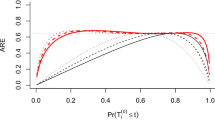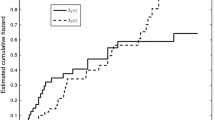Abstract
A Cox-type regression model accommodating heteroscedasticity, with a power factor of the baseline cumulative hazard, is investigated for analyzing data with crossing hazards behavior. Since the approach of partial likelihood cannot eliminate the baseline hazard, an overidentified estimating equation (OEE) approach is introduced in the estimation procedure. Its by-product, a model checking statistic, is presented to test for the overall adequacy of the heteroscedastic model. Further, under the heteroscedastic model setting, we propose two statistics to test the proportional hazards assumption. Implementation of this model is illustrated in a data analysis of a cancer clinical trial.
Similar content being viewed by others
References
O. O. Aalen, “Heterogeneity in survival analysis,” Statistics in Medicine vol. 7 pp. 1121–1137, 1988.
P. K. Andersen, Ø Borgan, R. D. Gill and N. Keiding, Statistical Models Based on Counting Processes, Springer-Verlag: New York, 1993.
N. E. Breslow, L. Edler and J. Berger, “A two-sample censored-data rank test for acceleration,” Biometrics vol. 40 pp. 1049–1062, 1984.
D. R. Cox, “Regression models and life-tables (with discussion),” Journal of the Royal Statistical Society, Series B vol. 34 pp. 187–220, 1972.
T. R. Fleming, J. R. O'Fallon, P. C. O'Brien, and D. P. Harrington, “Modified Kolmogorov-Smirnov test procedures with application to arbitrarily right-censored data,” Biometrics vol. 36 pp. 607–625, 1980.
M. H. Gail, S. Wieand, and S. Piantadosi, “Biased estimates of treatment effect in randomized experiments with nonlinear regression and omitted covariates,” Biometrika vol. 71 pp. 431–444, 1984.
S. Geman and C.-R. Hwang, “Nonparametric maximum likelihood estimation by the method of sieves,” The Annals of Statistics vol. 10 pp. 401–414, 1982.
R. D. Gill and M. Schumacher, “A simple test of the proportional hazards assumption,” Biometrika vol. 74 pp. 289–300, 1987.
P. Hougaard, “Life table method for heterogeneous populations: distributions describing the heterogeneity,” Biometrika vol. 71 pp. 75–83, 1984.
P. Hougaard, “Survival models for heterogeneous populations derived from stable distributions,” Biometrika vol. 73 pp. 387–396, 1986.
F. Hsieh, “The empirical process approach for semiparametric two-sample models with heterogeneous treatment effect,” Journal of the Royal Statistical Society, Series B vol. 57 pp. 735–748, 1995.
F. Hsieh, “A transformation model for two survival curves: an empirical process approach,” Biometrika vol. 83 pp. 519–528, 1996.
F. Hsieh, “On heteroscedastic hazards Regression models: theory and application,” Journal of the Royal Statistical Society, Series B vol. 63 (to appear), 2001.
D. Y. Lin, “Goodness of fit for the Cox regression model based on a class of parameter estimators,” Journal of The American Statistical Association vol. 86 pp. 725–728, 1991.
T. Moreau, J. O'Quigley, and M. Mesbah, “A global goodness-of-fit statistic for the proportional hazards model,” Applied Statistics vol. 34 pp. 212–218, 1985.
T. Moreau, J. Maccario, J. Lellouch, and C. Huber, “Weighted log rank statistics for comparing two distributions,” Biometrika vol. 79 pp. 195–198, 1992.
J. O'Quigley, “On a two-sided test for crossing hazards,” The Statistician vol. 43 pp. 563–569, 1994.
C. Quantin, T. Moreau, B. Asselain, T. Maccario, and J. Lellouch, “A regression survival model for testing the proportional hazards hypothesis,” Biometrics vol. 52 pp. 874–885, 1996.
D. Schoenfeld, “Chi-squared goodness-of-fit tests for the proportional hazards regression model,” Biometrika vol. 67 pp. 145–153, 1980.
D. M. Stablein and I. A. Koutrouvelis, “A two-sample test sensitive to crossing hazards in uncensored and singly censored data,” Biometrics vol. 41 pp. 643–652, 1985.
P. Tubert-Bitter, A. Kramar, J. J. Chalé, and T. Moreau, “Linear rank tests for comparing survival in two groups with crossing hazards,” Computational Statistics and Data Analysis vol. 18 pp. 547–559, 1994.
L. J. Wei, “Testing goodness-of-fit for the proportional hazards model with censored observations,” Journal of The American Statistical Association vol. 79 pp. 649–652, 1984.
Author information
Authors and Affiliations
Rights and permissions
About this article
Cite this article
Wu, HD.I., Hsieh, F. & Chen, CH. Validation of A Heteroscedastic Hazards Regression Model. Lifetime Data Anal 8, 21–34 (2002). https://doi.org/10.1023/A:1013566631377
Issue Date:
DOI: https://doi.org/10.1023/A:1013566631377




